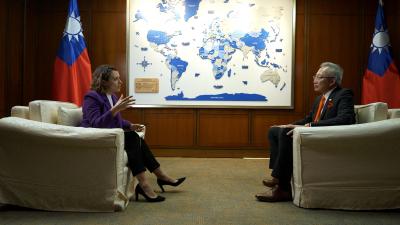Although atmospheric research has yet to help predict the weather with high accuracy, data and experience are increasing and scientists around the world are working toward that goal, the National Space Program Office (NSPO) said yesterday.
NSPO Director-General Miau Jiun-jih (苗君易) made the comment yesterday at the opening event of a three-day conference attended by some 300 international experts in the field. The conference includes the 4th biannual Asian Space Conference and the 3rd annual FORMOSAT-3/COSMIC workshop.
The FORMOSAT-3/COSMIC — a constellation of six micro-satellites — was launched by a Taiwan-US consortium in 2005.
The satellites are “immensely useful for weather forecasting and atmospheric research ... [which is important because] accurate weather forecasts would have a great impact in multiple disciplines,” such as agriculture and climatology, Miau said.
Miau said the equipment had already collected “almost 1.31 million units of data and has 842 subscribers at research institutions in 47 countries.”
“In addition, it has been incorporated into the weather forecast systems of many countries in Europe, Asia and the US,” Miau said.
The FORMOSAT-3/COSMIC workshop — “COSMIC” being short for Constellation Observing System for Meteorology, Ionosphere and Climate — will offer subscribers from around the world a chance to discuss uses for data collected by the equipment, Miau said.
“In the past two years, our meetings were more instructional, as some US researchers have more experience with satellites of this type ... However, we are confident that this year more researchers will be able to share data application methods with the group,” he said.
Researchers will also discuss how the data can be combined with non-satellite systems, such as radar, to provide the most comprehensive weather forecasts, Miau said.
“Increasing the accuracy of typhoon forecasts, for example, would require accumulating a lot more experience and analyzing past data [from previous storms],” he said.
In related news, the National Science Council yesterday unveiled the preliminary findings of its southwest front tracing project, which uses radar and dropsondes to better understand the interaction between seasonal winds and landscape, as well as how that interaction impacts Taiwan’s weather.
Project leader Ben Jou (周仲島) said that planes have been releasing dropsondes — weather observation instruments with parachutes — to the southwest of Taiwan, helping researchers put together a more detailed picture of the southwest front, which is responsible for heavy rain in the south in May and June.
More research will be needed, however, for the project to help improve weather forecasting, he said.

“China is preparing to invade Taiwan,” Deputy Minister of Foreign Affairs Francois Wu (吳志中) said in an exclusive interview with British media channel Sky News for a special report titled, “Is Taiwan ready for a Chinese invasion?” the Ministry of Foreign Affairs said today in a statement. The 25-minute-long special report by Helen Ann-Smith released yesterday saw Sky News travel to Penghu, Taoyuan and Taipei to discuss the possibility of a Chinese invasion and how Taiwan is preparing for an attack. The film observed emergency response drills, interviewed baseball fans at the Taipei Dome on their views of US President

ECONOMIC BENEFITS: The imports from Belize would replace those from Honduras, whose shrimp exports have dropped 67 percent since cutting ties in 2023 Maintaining ties with Taiwan has economic benefits, Ministry of Foreign Affairs officials said yesterday, citing the approval of frozen whiteleg shrimp imports from Belize by the Food and Drug Administration (FDA) as an example. The FDA on Wednesday approved the tariff-free imports from Belize after the whiteleg shrimp passed the Systematic Inspection of Imported Food, which would continue to boost mutual trade, the ministry said. Taiwan’s annual consumption of whiteleg shrimps stands at 30,000 tonnes, far exceeding domestic production, the ministry said. Taiwan used to fill the gap by importing shrimps from Honduras, but purchases slumped after Tegucigalpa severed diplomatic ties with Taiwan

The Executive Yuan yesterday approved a southwestern extension of the Sanying MRT Line from New Taipei to Bade District (八德) in Taoyuan, with a goal of starting construction by late 2026. The 4.03-kilometer extension, featuring three new stations, will run from the current terminus at Yingtao Fude Station (LB12) in New Taipei City to Dannan Station (LB14), where it will connect with Taoyuan’s Green Line, New Taipei City Metro Corp said in a statement. This extension will follow the completion of core Sanying Line, a 14.29-kilometer medium-capacity system linking Tucheng (土城), Sansia (三峽)

CARGO LOSS: About 50 containers at the stern of the ‘Ever Lunar’ cargo ship went overboard, prompting the temporary closure of the port and disrupting operations Evergreen Marine Corp, Taiwan’s largest container shipper, yesterday said that all crew members aboard the Ever Lunar (長月) were safe after dozens of containers fell overboard off the coast of Peru the previous day. The incident occurred at 9:40am on Friday as the Ever Lunar was anchored and waiting to enter the Port of Callao when it suddenly experienced severe rolling, Evergreen said in a statement. The rolling, which caused the containers to fall, might have been caused by factors including a tsunami triggered by an earthquake in Russia, poor winter sea conditions in South America or a sudden influx of waves,